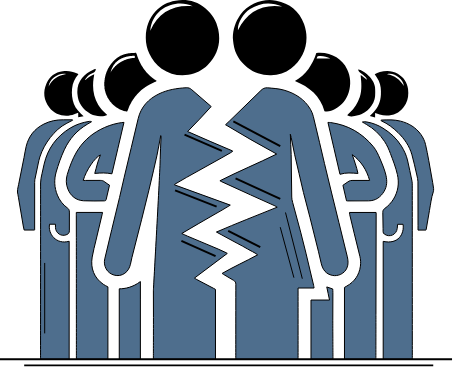Course: Genocide and Group Hostility
Module 4: Restoration
Restoration aims to ensure justice to victims after genocide. Combating impunity aims to prevent future atrocities and provide conditions for reconciliation.

Combating impunity in the aftermath of genocide calls for the concrete use of different accountability measures. Both legal and non-legal avenues can and should be pursued, each with their own strengths and specific goals.
Restorative justice
Restorative justice aims to repair the harm done to victims after genocides or other mass atrocities. It also aims to provide a basis for mending the relationship between victims and perpetrators, or at least provide conditions for reconciliation.
By creating opportunities for dialogue between those harmed by crime or conflict and those responsible for causing harm, restorative justice aims to acknowledge suffering, promote accountability, and help affected communities find ways to rebuild relations, even if full reconciliation may not be possible. There are several approaches to addressing this, involving both legal and non-legal measures in the aftermath of genocide and mass atrocities.
Case presentation: The Rwandan genocide
Rwanda is an example of a country where both legal and non-legal remedies have been tried after the 1994 genocide. From international processes and tribunals to home-grown solutions, many individuals involved in or affected by the genocide have engaged in efforts aimed at addressing the consequences and promoting justice.
Dohuzanye is a village of Hutu and Tutsi widows living together after the Rwandan genocide. They initially met in the local Gacaca courts. In these truth commissions, they held accountable those who killed their children just because their fathers were Tutsis. In this film, we meet some of these widows.
Like most countries on the African continent, Rwanda is diverse and complex, ethnically, linguistically, and religiously. As discussed in Module 1 – Genocide, ethnic conflicts between the Hutu majority and Tutsi minority have a long history, dating back to the time before Rwanda’s independence.
After the genocide in 1994, efforts have been made toward ethnic reconciliation and reconstruction. Distinctions between Hutu an Tutsi are now largely dismissed, with a stronger united Rwandan identity.
Accountability strategies
Accountability means that perpetrators are held responsible for their actions, which ensures justice to the victims. Enforcing accountability can help prevent future atrocities.
Legal Measures
Mass atrocities are crimes defined by the International Criminal Court, meaning that their prosecution requires strong legal approaches. National courts and laws bear the primary responsibility for preventing atrocities and prosecuting perpetrators, so below are examples of national-level measures relating to our main cases.
There are three main ways to prosecute perpetrators who have committed such crimes:
- international proceedings, by the ICC
- national tribunals
- 3rd countries, prosecuting perpetrators arrested there for crimes committed during other mass atrocities in another country
The International Criminal Court (ICC) is a permanent international tribunal established and governed by the Rome Statute. It is responsible for investigating and prosecuting individuals accused of committing the gravest international crimes, including genocide, war crimes, crimes against humanity, and the crime of aggression. Its primary goal is to hold perpetrators accountable and help prevent these atrocities from reoccurring.
Operating as a court of last resort, the ICC seeks to complement, not replace, national courts, stepping in when local jurisdictions are unable or unwilling to take action.
Case presentation: Accountability strategies in Rwanda
The International Criminal Tribunal for Rwanda (ICTR) issued the first ever conviction for the crime of genocide. Alongside it, the International Criminal Tribunal for the Former Yugoslavia (ICTY) has been the only other international tribunal which prosecuted atrocity crimes in modern times.
The ICTR was an ad-hoc tribunal with a specific mandate limited to Rwanda. It was created by United Nations Security Council Resolution 955 in 1994 and was distinct from the ICC, which was established under the Rome Statute.
Rwanda employed different types of courts to prosecute the people involved in the 1994 genocide, such as its national court system and grassroots Gacaca courts.
Gacaca courts were based on traditional forms of Rwandan justice. Local communities came together and created grassroots courts. The Gacaca courts dealt with individuals who expressed remorse for their participation in the genocide.
Through these courts, the communities would come together to address the specific crimes of individuals. Survivors and victims who attended the hearings could confront the defendants. The community would then decide on an appropriate punishment for those who admitted to committing atrocity crimes and were willing to take responsibility.
Throughout their existence, the Gacaca courts processed almost two million cases for genocide.
Case presentation: The Srebrenica Genocide
Legal accountability is not sufficient to bring justice after atrocity crimes. Without comprehensive restoration processes, those harmed by atrocities and those who perpetrated them may not be able to coexist.
Case presentation: The Yazidi Genocide
No international tribunal has been established for the prosecution of the perpetrators of the Yazidi genocide. Since Iraq is not a signatory state to the Rome Statute, the ICC cannot be directly involved. Nevertheless, individual trials have been held in Iraq Germany, and Sweden.
Similarly, in 2025, a woman in Sweden was convicted of committing genocide, crimes against humanity, and gross war crimes against women and children of the Yazidi community. (Stockholm Supreme Court)
Women as actors for restoration and justice - Ashwaq's story
Ashwaq
Non-legal measures
The Genocide Convention obliges states to prevent genocide not only through legal means. Implementing non-legal measures does not require definite proof that a genocide is about to unfold.
Documenting atrocity crimes is an important step towards accountability processes and restorative justice. Documentation centers and initiatives, along with truth commissions and investigative bodies, aim to concretely understand what crimes happened, who perpetrated them, and against whom.
Here are some relevant to our case studies:
Gender-sensitive restorative justice
Restorative justice processes may sometimes overlook the gendered dimensions of atrocity crimes. To address this limitation, frameworks that incorporate gender considerations into the understanding of mass atrocities may strengthen the relevance and effectiveness of restorative justice processes.
In 1998, during the sentencing of Jean Paul Akayesu in the ICTR, rape was recognized for the first time as a weapon of genocide. This recognition was groundbreaking, leading to its definition in international criminal law. Nevertheless, establishing rape as an explicit tool of genocide in court presents significant legal challenges.
The Rwandan genocide included hundreds of thousands of cases of sexual violence, in addition to the mass killings. Women and children were targeted for this purpose, so much so that UN Special Rapporteur René Degni-Ségui stated “Rape was the rule, and its absence the exception”.
Special Representative of the Secretary-General on Sexual Violence in Conflict Pramila Patten discusses the consequences of the campaign of mass rape carried out as a part of the genocide.
Children Born of War
As rape and sexual violence is often employed as a weapon in armed conflicts and genocides, it has given validity to the conception of Children Born of War (CBOW). These children are often marginalized or mistreated due to their inherent association with their perpetrator’s actions and identity.
Ajna Jusic is one of the 4000 children conceived during the mass rapes perpetrated during the Balkan wars of the 1990s.
Restorative justice for women who are victims of sexual violence and their children requires a multifaceted approach. Along with mental, physical, and social support, identifying perpetrators can help victims confront their assailants and seek accountability for the violence they endured.
Yazidi women raped by ISIS fighters have given birth to children whose father’s religious identity is different from the Yazidi faith. According to Iraqi law and prevailing social expectations of parentage, these children would follow the father’s religion. The undesired pregnancy and children born of such rape can often damage and split communities.
During the Rwandan genocide, widespread rape and sexual violence occurred alongside other atrocities. Although establishing rape as an explicit tool of genocide in court has its own legal challenges, evidence indicates that sexual violence, forced impregnation, and the deliberate spread of HIV were used to terrorize and destabilize the Tutsi population.
Questions for reflection and discussion
- What role can restorative justice have in addressing the experiences and accountability processes for both victims and perpetrators of genocide?
- In what ways may gender-sensitive restorative justice address violence in genocide and mass atrocities differently from other measures?
- What are the legal advantages and disadvantages of focusing on intent to classify acts as genocide?
- Case Discussion: Based on the cases discussed, what key insights and effective legal and non-legal measures can be identified for addressing concerns related to genocide and other mass atrocities? Consider all available resources, including relevant international and national rulings associated with these cases.
For Educators
- When educating students about international law addressing impunity after genocide, it’s important to discuss the challenges in implementing this in practice.
- Challenges are typically due to a lack of political will and resistance from states, which limit the effectiveness of international bodies and national mechanisms for restoration.
- For more information about using films for education, please see our For Educators page.
Additional Resources
Legal measures
- Nwoye, Leo C. 2016. “Transitional Justice and the ICC: Lessons from Rwanda.” In The International Criminal Court and Africa: One Decade On, edited by Evelyn A Ankumah, 549–92. Cambridge: Intersentia. (link)
- Kottou, Eva. 2022. “International Criminal Court Addressing the 1994 Rwandan Genocide in 2022: Is It Too Late for Justice?” The Yale Review of International Studies, November. (link)
More on the case studies



